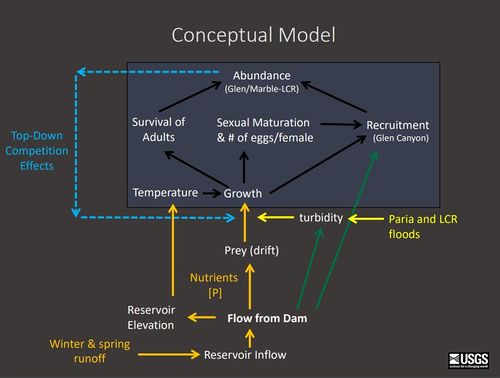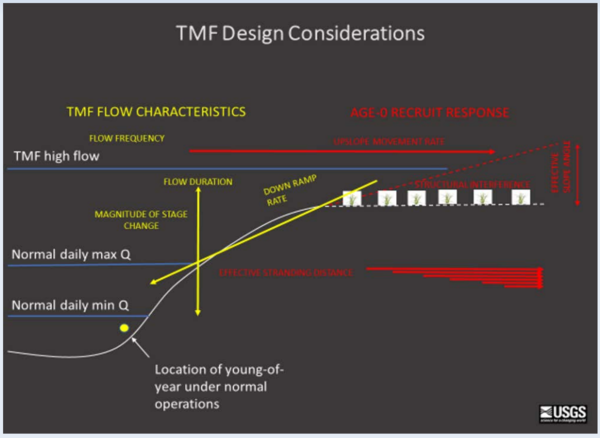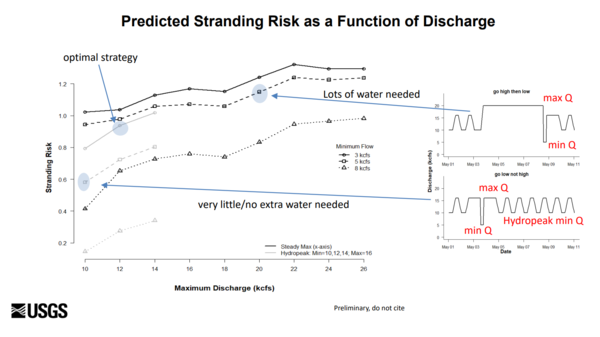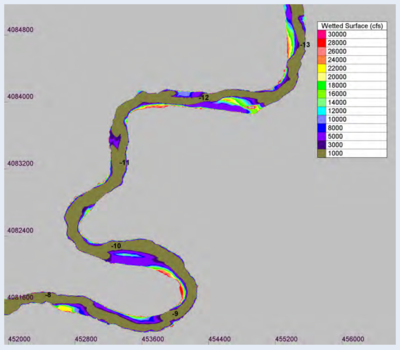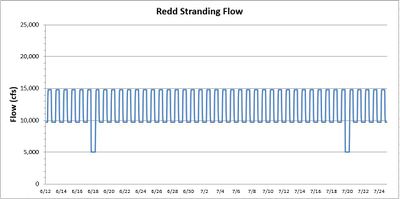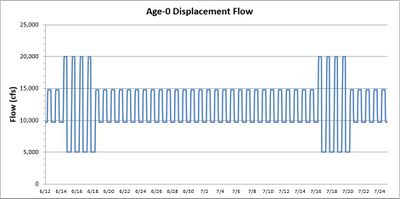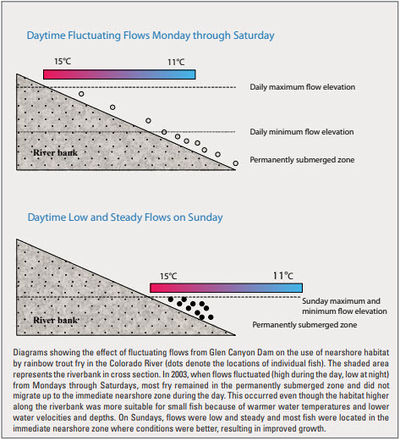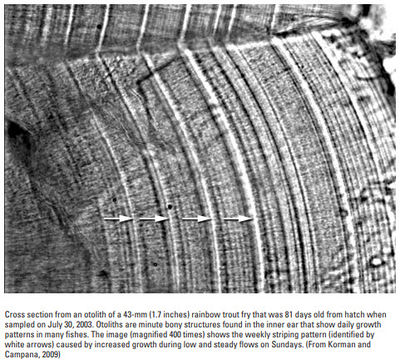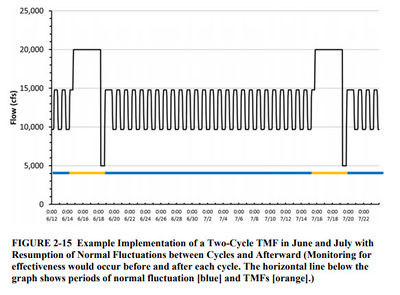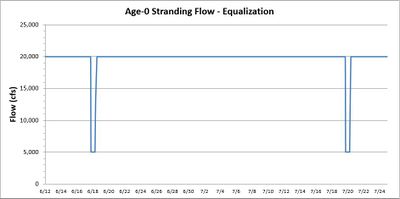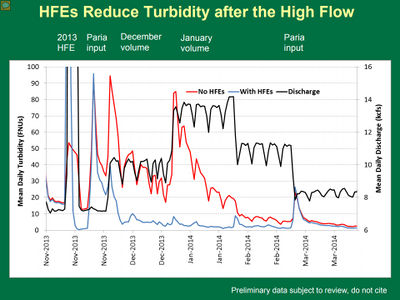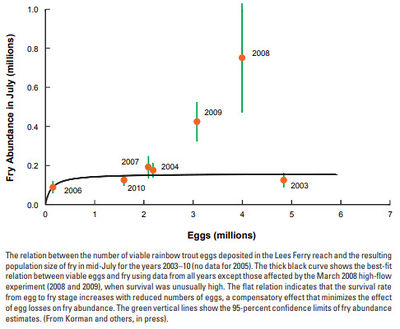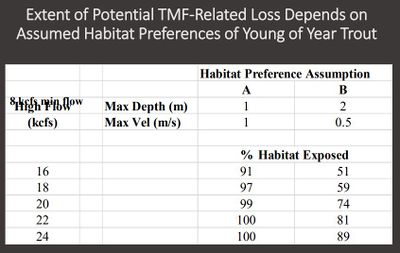Difference between revisions of "Trout Management Flows"
Cellsworth (Talk | contribs) |
Cellsworth (Talk | contribs) |
||
| (28 intermediate revisions by the same user not shown) | |||
| Line 17: | Line 17: | ||
</table> | </table> | ||
| − | [[File:TMF conceptual model.JPG| | + | [[File:TMF conceptual model.JPG|500px|center|thumbnail|[[Media:TMF June 2019 Revised.pdf| Trout Management Flows: A Review of Data, Research Results, and Information Needs ]] ]] |
<!-- | <!-- | ||
| Line 52: | Line 52: | ||
|class="MainPageBG" style="width:55%; border:1px solid #cef2e0; background:#f5faff; vertical-align:top; color:#000;"| | |class="MainPageBG" style="width:55%; border:1px solid #cef2e0; background:#f5faff; vertical-align:top; color:#000;"| | ||
{|width="100%" cellpadding="2" cellspacing="5" style="vertical-align:top; background:#f5faff;" | {|width="100%" cellpadding="2" cellspacing="5" style="vertical-align:top; background:#f5faff;" | ||
| − | ! <h2 style="margin:0; background:#cedff2; font-size:120%; font-weight:bold; border:1px solid #a3bfb1; text-align:left; color:#000; padding:0.2em 0.4em;"> | + | ! <h2 style="margin:0; background:#cedff2; font-size:120%; font-weight:bold; border:1px solid #a3bfb1; text-align:left; color:#000; padding:0.2em 0.4em;">Trout Management Flow (TMF) Uncertainties</h2> |
|- | |- | ||
|style="color:#000;"| | |style="color:#000;"| | ||
| + | |||
| + | *How high does the max flow (Q) need to be? | ||
| + | *Duration at the max flow and min flow? | ||
| + | *How fast does the down-ramp rate need to be? | ||
| + | *What kind of habitat induces more stranding? And what proportion of Glen Canyon comprises that habitat type? | ||
| + | *How many cycles of TMFs need to be implemented in one season? | ||
| + | *What is the overall population abundance response to TMFs? | ||
| + | *Will this work for Brown Trout? If so, what differences need to be considered? [https://www.usbr.gov/uc/progact/amp/twg/2022-01-13-twg-meeting/20220113-AnnualReportingMeeting-TroutManagementFlows-508-UCRO.pdf] | ||
| + | |||
| + | [[File:TMFmodel.PNG|600px|center|thumbnail|https://www.usbr.gov/uc/progact/amp/twg/2022-01-13-twg-meeting/20220113-AnnualReportingMeeting-TroutManagementFlows-508-UCRO.pdf]] | ||
| + | |||
| + | [[File:StrandingRisk.PNG|thumb|center|600px|https://www.usbr.gov/uc/progact/amp/twg/2022-01-13-twg-meeting/20220113-AnnualReportingMeeting-TroutManagementFlows-508-UCRO.pdf]] | ||
| + | |||
| + | |- | ||
| + | ! <h2 style="margin:0; background:#cedff2; font-size:120%; font-weight:bold; border:1px solid #a3b0bf; text-align:left; color:#000; padding:0.2em 0.4em;"> '''Predicted Wetted Area - Glen Canyon''' </h2> | ||
| + | |- | ||
| + | |style="color:#000;"| | ||
| + | |||
| + | [[File:GlenCanyonBethometry.PNG|thumb|right|400px|https://www.usbr.gov/uc/progact/amp/twg/2022-01-13-twg-meeting/20220113-AnnualReportingMeeting-TroutManagementFlows-508-UCRO.pdf]] | ||
| + | |||
| + | Large areas exposed between 26-18 kcfs | ||
| + | *Stranding fry over this flow range requires sustained high flows of ~ 26 kcfs. | ||
| + | *Only feasible in equalization years (e.g. 2011) | ||
| + | |||
| + | Large areas exposed between 5-3 kcfs | ||
| + | *Dropping flows from normal daytime highs of ~ 16-18 kcfs to 3 kcfs is feasible given constraints on release volume | ||
| + | |||
| + | Majority of shoreline in Glen Canyon is steep | ||
| + | *TMFs have to occur when young fry (< 50 mm) are using low angle shorelines | ||
| + | *Not all young fry will be using habitats that are vulnerable to stranding | ||
| + | |||
| + | |- | ||
| + | ! <h2 style="margin:0; background:#cedff2; font-size:120%; font-weight:bold; border:1px solid #a3b0bf; text-align:left; color:#000; padding:0.2em 0.4em;"> '''Possible Trout Management Flow (TMF) Treatments''' </h2> | ||
| + | |- | ||
| + | |style="color:#000;"| | ||
| + | |||
| + | [[File:TMF_ReddStranding.JPG|thumb|right|400px|https://www.usbr.gov/uc/progact/amp/twg/2022-01-13-twg-meeting/20220113-AnnualReportingMeeting-TroutManagementFlows-508-UCRO.pdf]] | ||
==Treatment 1: Redd stranding flows (with mechanical removal of redds below the minimum flow elevation)== | ==Treatment 1: Redd stranding flows (with mechanical removal of redds below the minimum flow elevation)== | ||
| Line 73: | Line 110: | ||
==Treatment 2: Age-0 Trout Displacement Flows== | ==Treatment 2: Age-0 Trout Displacement Flows== | ||
| + | |||
| + | [[File:TMF_Displacement_(1).JPG|thumb|right|400px]] | ||
[[File:TroutRestrictiveMovement.jpg|thumb|right|400px|[https://pubs.usgs.gov/fs/2011/3002/fs2011-3002.pdf Korman and Campana 2009] ]] | [[File:TroutRestrictiveMovement.jpg|thumb|right|400px|[https://pubs.usgs.gov/fs/2011/3002/fs2011-3002.pdf Korman and Campana 2009] ]] | ||
[[File:TroutOtolith.jpg|thumb|right|400px|[https://pubs.usgs.gov/fs/2011/3002/fs2011-3002.pdf Korman and Campana 2009] ]] | [[File:TroutOtolith.jpg|thumb|right|400px|[https://pubs.usgs.gov/fs/2011/3002/fs2011-3002.pdf Korman and Campana 2009] ]] | ||
| − | + | ||
| − | + | ||
| − | + | ||
This treatment relies on increased daily flow fluctuations to reduce the habitat availability of age-0 trout (fry and juveniles). This would make age-0 trout more reliant on sub-optimal habitats where they would be subject | This treatment relies on increased daily flow fluctuations to reduce the habitat availability of age-0 trout (fry and juveniles). This would make age-0 trout more reliant on sub-optimal habitats where they would be subject | ||
to poorer growing conditions. Daily flow fluctuations have been shown to negatively impact age-0 trout without affecting larger trout (Makinster et al. 2011). Under this flow regime age-0 trout are more likely to remain in | to poorer growing conditions. Daily flow fluctuations have been shown to negatively impact age-0 trout without affecting larger trout (Makinster et al. 2011). Under this flow regime age-0 trout are more likely to remain in | ||
| Line 90: | Line 127: | ||
==Treatment 3: Age-0 Trout Stranding Flows== | ==Treatment 3: Age-0 Trout Stranding Flows== | ||
| + | |||
[[File:LTEMPtmf.jpg|thumb|right|400px|Example of a possible TMF illustrated in the LTEMP FEIS]] | [[File:LTEMPtmf.jpg|thumb|right|400px|Example of a possible TMF illustrated in the LTEMP FEIS]] | ||
| + | [[File:TMF_Stranding_HFE.JPG|thumb|right|400px]] | ||
| + | [[File:TMF_Stranding_Equalization.JPG|thumb|right|400px]] | ||
| + | |||
This treatment relies on a period of high steady flows to draw age-0 trout (fry and juveniles) onto high elevation gravel bars and benches and then stranding those fish by rapidly decreasing releases from Glen Canyon Dam. Age-0 trout stranding flows could be provided within ROD guidelines with the treatment consisting of a period of high steady flows for an extended period of time to encourage age-0 trout to inhabit high elevation gravel bars and benches. Flows would then be rapidly reduced to the lowest allowable minimum flow for a dewatering treatment lasting 10-12 hours and occurring every 2-4 weeks. This treatment would take place from May to August when age-0 trout are most likely to be in these near-shore habitats. A nighttime minimum flow treatment may be more effective than a daytime treatment because age-0 trout typically come closer into shore at night. Increasing downramp rates and reducing flows below ROD guidelines may make this treatment more effective. The ROD currently limits downramp rates to 2,500 cfs/hr to reduce the probability of stranding young fish in nearshore habitats. Operationally, down ramping from 33,200 cfs (maximum power plant capacity at Glen Canyon Dam) to the daily minimum could occur nearly instantaneously. | This treatment relies on a period of high steady flows to draw age-0 trout (fry and juveniles) onto high elevation gravel bars and benches and then stranding those fish by rapidly decreasing releases from Glen Canyon Dam. Age-0 trout stranding flows could be provided within ROD guidelines with the treatment consisting of a period of high steady flows for an extended period of time to encourage age-0 trout to inhabit high elevation gravel bars and benches. Flows would then be rapidly reduced to the lowest allowable minimum flow for a dewatering treatment lasting 10-12 hours and occurring every 2-4 weeks. This treatment would take place from May to August when age-0 trout are most likely to be in these near-shore habitats. A nighttime minimum flow treatment may be more effective than a daytime treatment because age-0 trout typically come closer into shore at night. Increasing downramp rates and reducing flows below ROD guidelines may make this treatment more effective. The ROD currently limits downramp rates to 2,500 cfs/hr to reduce the probability of stranding young fish in nearshore habitats. Operationally, down ramping from 33,200 cfs (maximum power plant capacity at Glen Canyon Dam) to the daily minimum could occur nearly instantaneously. | ||
| Line 97: | Line 138: | ||
likely to exhibit a density-dependent response. This treatment, however, may also strand larger, more desirable trout occupying nearshore habitat during the night as well. Any larger fish caught in the nearshore during a | likely to exhibit a density-dependent response. This treatment, however, may also strand larger, more desirable trout occupying nearshore habitat during the night as well. Any larger fish caught in the nearshore during a | ||
stranding event would likely be more susceptible to mortality than smaller, age-0 fish because they would not be able to escape or endure the stranding as readily as a smaller fish. | stranding event would likely be more susceptible to mortality than smaller, age-0 fish because they would not be able to escape or endure the stranding as readily as a smaller fish. | ||
| − | |||
==Treatment 4: Increase or Maintain Turbidity in Marble Canyon during Periods of High Trout Recruitment== | ==Treatment 4: Increase or Maintain Turbidity in Marble Canyon during Periods of High Trout Recruitment== | ||
| Line 107: | Line 147: | ||
Increasing turbidity in Marble Canyon to the levels discussed here would likely not impact humpback chub and other native fish since they evolved in a turbid river environment. This treatment has the potential to be able to reduce the Program’s reliance on mechanical removal and other more lethal and expensive approaches to TMFs that some groups (i.e. Tribes, anglers, power users, etc.) find objectionable. Increased turbidity may also reduce direct predation pressure on native fish by nonnative fish like rainbow trout. Predation by other nonnative fish, like brown trout, appear not to be affected by the levels of turbidity being discussed here. Reducing the number of fall HFEs would have a negative impact to sediment-related resources unless the sediment accounting periods in the HFE protocol could be adjusted to allow for fall sediment from the Paria be used for a spring HFE, of which a number of resources would benefit including foodbase, the trout fishery, and recreational beach use. | Increasing turbidity in Marble Canyon to the levels discussed here would likely not impact humpback chub and other native fish since they evolved in a turbid river environment. This treatment has the potential to be able to reduce the Program’s reliance on mechanical removal and other more lethal and expensive approaches to TMFs that some groups (i.e. Tribes, anglers, power users, etc.) find objectionable. Increased turbidity may also reduce direct predation pressure on native fish by nonnative fish like rainbow trout. Predation by other nonnative fish, like brown trout, appear not to be affected by the levels of turbidity being discussed here. Reducing the number of fall HFEs would have a negative impact to sediment-related resources unless the sediment accounting periods in the HFE protocol could be adjusted to allow for fall sediment from the Paria be used for a spring HFE, of which a number of resources would benefit including foodbase, the trout fishery, and recreational beach use. | ||
| − | |||
|- | |- | ||
| Line 153: | Line 192: | ||
*[http://gcdamp.com/index.php?title=Long-term_Experimental_and_Management_Plan_(LTEMP) LTEMP EIS wiki page] | *[http://gcdamp.com/index.php?title=Long-term_Experimental_and_Management_Plan_(LTEMP) LTEMP EIS wiki page] | ||
*[http://gcdamp.com/index.php?title=Turbidity Turbidity wiki page] | *[http://gcdamp.com/index.php?title=Turbidity Turbidity wiki page] | ||
| + | |||
| + | |- | ||
| + | ! <h2 style="margin:0; background:#cedff2; font-size:120%; font-weight:bold; border:1px solid #a3b0bf; text-align:left; color:#000; padding:0.2em 0.4em;"> Possible mechanisms that might control trout reproduction </h2> | ||
| + | |- | ||
| + | |style="color:#000;"| | ||
| + | |||
| + | *Stranding | ||
| + | *Displacement into suboptimal habitats | ||
| + | *Increasing turbidity (makes it harder for trout to find food) | ||
| + | *Mechanical removal (angling, electrofishing, etc.) | ||
| + | *Manipulating food supplies (Bugflows, spring release, nutrients, etc.) | ||
|- | |- | ||
| Line 180: | Line 230: | ||
*Model net effect of reduced trout abundance and higher turbidity on Humpback Chub at the LCR (Dzul/Yackulic). | *Model net effect of reduced trout abundance and higher turbidity on Humpback Chub at the LCR (Dzul/Yackulic). | ||
*Need to improve trout monitoring in Marble Canyon if managers decide to use trout abundance as one of the HFE triggers [https://www.usbr.gov/uc/progact/amp/twg/2018-01-25-twg-meeting/AR12.pdf] | *Need to improve trout monitoring in Marble Canyon if managers decide to use trout abundance as one of the HFE triggers [https://www.usbr.gov/uc/progact/amp/twg/2018-01-25-twg-meeting/AR12.pdf] | ||
| + | |||
| + | |- | ||
| + | ! <h2 style="margin:0; background:#cedff2; font-size:120%; font-weight:bold; border:1px solid #a3b0bf; text-align:left; color:#000; padding:0.2em 0.4em;"> Susceptibility timing of trout to TMFs </h2> | ||
| + | |- | ||
| + | |style="color:#000;"| | ||
| + | |||
| + | ===Rainbow trout=== | ||
| + | *Peak spawn in March-April | ||
| + | *Peak emergence in May-June | ||
| + | *Young rainbow trout most vulnerable to flow changes shortly after emergence = May-July* | ||
| + | Young of year trout are likely most vulnerable to stranding May-June. Efficacy of TMFs in July and August are uncertain. [http://gcdamp.com/images_gcdamp_com/6/60/TMF_June_2019_Revised.pdf] | ||
| + | |||
| + | ===Brown trout=== | ||
| + | *Peak spawn in October to December [https://www.usbr.gov/uc/progact/amp/amwg/2017-09-20-amwg-meeting/BT03.pdf] | ||
| + | *Peak emergence in February to April | ||
| + | *Young brown trout most vulnerable to flow changes shortly after emergence = February to April | ||
|- | |- | ||
| Line 186: | Line 252: | ||
|style="color:#000;"| | |style="color:#000;"| | ||
| − | *Hydropower: value | + | *Hydropower: reduction in value and capacity |
| − | *Foodbase: production, drift, availability | + | *Foodbase: reduction in production, drift, and food availability |
| − | *Native fish: stranding | + | *Native fish: increase in stranding |
| − | *Tribal sensitivities: sanctity of life | + | *Tribal sensitivities: concerns of intentionally killing fish and sanctity of life |
| − | *Lees Ferry fishery: | + | *Lees Ferry fishery: concerns of intentionally killing a sport fish, perceptions that the sport fishery is being suppressed and associated reduction in people coming to fish |
| − | *Boater safety: | + | *Boater safety: reduced access to the Lees Ferry reach and difficulty in navigating rapids in Grand Canyon due to low flows, increased variation from normal operations and having to track flows |
| − | * | + | *Recreation: increased sediment transport and beach erosion |
| + | |||
| + | |- | ||
| + | ! <h2 style="margin:0; background:#cedff2; font-size:120%; font-weight:bold; border:1px solid #a3b0bf; text-align:left; color:#000; padding:0.2em 0.4em;"> LTEMP descriptions of a TMF </h2> | ||
| + | |- | ||
| + | |style="color:#000;"| | ||
| + | |||
| + | ===Characteristics of a TMF=== | ||
| + | *Repeated fluctuation cycles that consist of relatively high flows | ||
| + | *Up-ramp rates: 4,000 cfs/hr | ||
| + | *High flows are sustained for a period of time | ||
| + | *Followed by a rapid drop to a very low flow, down-ramp from peak to base would be over a single hour | ||
| + | *Low flow would be maintained for a period of less than a day and would be timed to start in the morning, after sunrise | ||
| + | *Can be implemented from May through August | ||
| + | |||
| + | ===Testing=== | ||
| + | *First tests could be triggered by modeled trout recruitment levels or otherwise implemented to test the effectiveness of TMFs | ||
| + | *Tests would start with a conservative application of two cycles in June and July, but could be increased based on experimental testing to as many as three cycles per month for 3 months (May, June, and July) | ||
| + | *TMFs would be tested two to three times in the early part of the LTEMP period while attempting to minimize confounding effects with other experimental treatments | ||
| + | *If TMFs are determined to be effective while minimizing impacts on other resources, they may be deployed on a regular or triggered basis by estimated trout recruitment | ||
| + | *Effectiveness would be judged based on comparison of fall trout recruitment estimates to expectations based on prior years | ||
| + | *Due to concerns regarding the risk associated with implementation of spring HFEs and a related trout response and subsequent effects on the humpback chub population, TMFs would be implemented and tested for effectiveness as early in the LTEMP period as possible, preferably before the first spring HFEs are triggered, even if not triggered by high trout recruitment. | ||
| + | |||
| + | ===Triggers=== | ||
| + | *For the EIS modeling, a trigger of 200,000 YOY trout was used to determine when TMFs would be implemented | ||
| + | *The LTEMP trigger was based on a regression equation involving annual volume, the variability in flows from May through August, and the occurrence of a spring HFE yielding a predicted number of YOY rainbow trout. | ||
| + | *The actual trigger used could be higher or lower depending on the results of experiments that will be conducted on the effectiveness of TMFs. | ||
| + | *The predictive regression equation could be modified based on new information. | ||
| + | *Triggers for implementation of TMFs would also be developed in consultation with the AZGFD and other entities as appropriate. | ||
| + | *Monitoring of other resources, particularly food base and the physiologic condition of adult rainbow trout, would also be considered. | ||
| + | *The number of YOY trout at the end of the summer would be estimated to determine if it equals or exceeds the estimated number of recruits needed to sustain the desired number of adult trout. If the estimated number of recruits is less than the recruitment target, TMFs would be re-evaluated for modification before implementation in subsequent years. | ||
| + | *If there is an observed increase in trout recruitment due to fall HFEs, then application of TMFs in the spring following a fall HFE would be considered. | ||
| + | |||
| + | ===Implementation=== | ||
| + | *TMFs could be implemented in years that feature a spring HFE and in the water year that follows an equalization flow because of the expected positive effects of equalization on rainbow trout recruitment. | ||
| + | *Any implementation of TMFs would consider the status of the trout fishery prior to implementation. | ||
| + | *Modeling indicates TMFs would be triggered by trout recruitment numbers in 32% of the years in the LTEMP period. | ||
| + | *Timing of TMFs may also be adjusted based on the best scientific information available related to trout emigration behavior. | ||
|- | |- | ||
| Line 198: | Line 301: | ||
|- | |- | ||
|style="color:#000;"| | |style="color:#000;"| | ||
| + | |||
| + | '''2024''' | ||
| + | *[[Media:Giardina_2024_TMF_review_ofr20241033.pdf|Giardina et al., 2024, A literature review and hypsometric analysis to support decisions on trout management flows on the Colorado River downstream from Glen Canyon Dam]] | ||
| + | |||
| + | '''2022''' | ||
| + | *[https://www.usbr.gov/uc/progact/amp/twg/2022-10-13-twg-meeting/20221013-TroutManagementFlowsLiteraturReviewStrandingRiskModelling-508-UCRO.pdf Trout Management Flows A Literature Review and Stranding Risk Modelling ] | ||
| + | *[https://www.usbr.gov/uc/progact/amp/twg/2022-06-16-twg-meeting/20220616-TroutManagementFlowsWhitePaper-Presentation-508-UCRO.pdf Trout Management Flows White Paper ] | ||
| + | *[https://www.usbr.gov/uc/progact/amp/twg/2022-06-16-twg-meeting/20220616-ConsiderationsImplementationTroutManagementFlowExperiment-508-UCRO.pdf Considerations for Implementation of a Trout Management Flow Experiment ] | ||
| + | *[https://www.usbr.gov/uc/progact/amp/twg/2022-01-13-twg-meeting/20220113-AnnualReportingMeeting-TroutManagementFlows-508-UCRO.pdf Trout Management Flows - A Literature Review and Stranding Risk Modelling Component Project H ] | ||
| + | *[https://www.usbr.gov/uc/progact/amp/twg/2022-01-13-twg-meeting/20220113-AnnualReportingMeeting-EstimatingEfficacyTroutManagementFlows-508-UCRO.pdf Estimating the efficacy of trout management flows using bioeconomic and hydropower modeling ] | ||
| + | |||
| + | '''2020''' | ||
| + | *[https://www.usbr.gov/uc/progact/amp/twg/2020-01-13-twg-meeting/20200113-AnnualReportingMeeting-TroutRecruitmentGrowthPopulationDynamics-Presentation-508-UCRO.pdf TRGD: Trout Recruitment, Growth and Population Dynamics ] | ||
'''2019''' | '''2019''' | ||
| Line 212: | Line 328: | ||
'''2016''' | '''2016''' | ||
| − | *Yard, M.D., Korman, J., Walters, C.J., and T.A. Kennedy. 2016. Seasonal and spatial | + | *Yard, M.D., Korman, J., Walters, C.J., and T.A. Kennedy. 2016. Seasonal and spatial patterns of growth of rainbow trout in the Colorado River in Grand Canyon Arizona. Can. J. Fish. Aquat. Sci. 73:125-139. |
*Korman, J, Yard, M.D., and C.B. Yackulic. 2016. Factors controlling the abundance of rainbow trout in the Colorado River in Grand Canyon in a reach utilized by endangered humpback chub. Can. J. Fish. Aquat. Sci. 73:105-124. | *Korman, J, Yard, M.D., and C.B. Yackulic. 2016. Factors controlling the abundance of rainbow trout in the Colorado River in Grand Canyon in a reach utilized by endangered humpback chub. Can. J. Fish. Aquat. Sci. 73:105-124. | ||
*[https://www.usbr.gov/uc/progact/amp/twg/2016-02-26-twg-meeting/Attach_07b.pdf Lees Ferry Recreational Trout Fishery Management Recommendations: The Voice of Lees Ferry Recreational Anglers, Guides, and Businesses] | *[https://www.usbr.gov/uc/progact/amp/twg/2016-02-26-twg-meeting/Attach_07b.pdf Lees Ferry Recreational Trout Fishery Management Recommendations: The Voice of Lees Ferry Recreational Anglers, Guides, and Businesses] | ||
'''2015''' | '''2015''' | ||
| + | *[https://www.researchgate.net/publication/281479779_Factors_Controlling_the_Abundance_of_Rainbow_Trout_in_the_Colorado_River_in_Grand_Canyon_in_a_Reach_Utilized_by_Endangered_Humpback_Chub Korman et al. 2015. Factors Controlling the Abundance of Rainbow Trout in the Colorado River in Grand Canyon in a Reach Utilized by Endangered Humpback Chub. Canadian Journal of Fisheries and Aquatic Sciences] | ||
*[https://www.usbr.gov/uc/progact/amp/twg/2015-04-21-twg-meeting/Attach_11.pdf Glen Canyon Tailwater Fishery “Integrating Fish and Channel Mapping”] | *[https://www.usbr.gov/uc/progact/amp/twg/2015-04-21-twg-meeting/Attach_11.pdf Glen Canyon Tailwater Fishery “Integrating Fish and Channel Mapping”] | ||
*[http://onlinelibrary.wiley.com/doi/10.1080/02755947.2015.1040560/abstract Avery et al. 2015. Effects of Increased Discharge on Spawning and Age-0 Recruitment of Rainbow Trout in the Colorado River at Lees Ferry, Arizona. NAJFM] | *[http://onlinelibrary.wiley.com/doi/10.1080/02755947.2015.1040560/abstract Avery et al. 2015. Effects of Increased Discharge on Spawning and Age-0 Recruitment of Rainbow Trout in the Colorado River at Lees Ferry, Arizona. NAJFM] | ||
| Line 240: | Line 357: | ||
'''2009''' | '''2009''' | ||
| − | |||
*[http://www.tandfonline.com/doi/abs/10.1577/T08-025.1?src=recsys&journalCode=utaf20 Korman et al. 2009. Effects of Fish Size, Habitat, Flow, and Density on Capture Probabilities of Age-0 Rainbow Trout Estimated from Electrofishing at Discrete Sites in a Large River. TAFS] | *[http://www.tandfonline.com/doi/abs/10.1577/T08-025.1?src=recsys&journalCode=utaf20 Korman et al. 2009. Effects of Fish Size, Habitat, Flow, and Density on Capture Probabilities of Age-0 Rainbow Trout Estimated from Electrofishing at Discrete Sites in a Large River. TAFS] | ||
| − | *[https://www.usbr.gov/uc/progact/amp/twg/2009-03-16-twg-meeting/Attach_18.pdf Effects of Hydropeaking on Nearshore Habitat Use and Growth of Age | + | *[https://www.usbr.gov/uc/progact/amp/twg/2009-03-16-twg-meeting/Attach_18.pdf Korman and Campana. 2009. Effects of Hydropeaking on Nearshore Habitat Use and Growth of Age 0 Rainbow Trout in a Large Regulated River. TAFS] |
| − | ''' | + | '''2005''' |
| − | * | + | *[https://www.researchgate.net/publication/267839345_Effects_of_the_Experimental_Fluctuating_Flows_from_Glen_Canyon_Dam_in_2003_and_2004_on_the_Early_Life_History_Stages_of_Rainbow_Trout_in_the_Colorado_River Korman et al., 2005, Effects of the Experimental Fluctuating Flows from Glen Canyon Dam in 2003 and 2004 on the Early Life Stages of Rainbow Trout in the Colorado River, final report, U.S. Geological Survey, Grand Canyon Monitoring and Research Center, Flagstaff, Ariz.] |
| + | *[https://www.usbr.gov/uc/progact/amp/twg/2005-05-18-twg-meeting/Attach_06.pdf Effects of 2003/2004 GCD Enhanced Fluctuating Flows on the Early Life History Stages of Rainbow Trout in Glen Canyon] | ||
| − | + | '''2003''' | |
| − | + | *[https://www.usbr.gov/uc/progact/amp/amwg/2003-08-13-amwg-meeting/Attach_04.pdf Stranding of Adult Rainbow Trout during Experimental Fluctuating Releases from Glen Canyon Dam on the Colorado River] | |
| − | + | ||
| − | + | ||
| − | ''' | + | '''2002''' |
| − | * | + | *[https://www.usbr.gov/uc/envdocs/ea/gc/PropExpReleasesEA-09-2002.pdf Environmental Assessment for Proposed Experimental Releases from Glen Canyon Dam and Removal of Non-Native Fish ] |
| − | + | ||
| − | + | ||
| − | ''' | + | '''1995''' |
| − | * | + | *Valdez and Ryel, 1995 |
| − | + | ||
| − | + | ||
| − | + | ||
| − | + | ||
| − | + | ||
| − | + | ||
| − | + | ||
| − | + | ||
| − | + | ||
| − | + | ||
|- | |- | ||
| Line 446: | Line 549: | ||
Little Colorado River reach. TMFs would be tested early in the experimental | Little Colorado River reach. TMFs would be tested early in the experimental | ||
period, preferably in the first 5 years. Under the LTEMP EIS, TMFs could occur from May to August. | period, preferably in the first 5 years. Under the LTEMP EIS, TMFs could occur from May to August. | ||
| + | |||
| + | ==Biological Opinion, page 72== | ||
| + | LTEMP includes implementation of ongoing and new conservation measures that are | ||
| + | designed to reduce the effects of the proposed action and improve the status of humpback | ||
| + | chub. Conservation measures identified in the 2011 BO on operations of Glen Canyon | ||
| + | Dam (USFWS 2011a) included the establishment of a humpback chub refuge, which has | ||
| + | been created and will continue to be funded as a part of this action. Other conservation | ||
| + | measures include humpback chub translocation; Bright Angel Creek brown trout control; | ||
| + | '''determination of the feasibility of flow options to control trout, including increasing daily down-ramp rates to strand or displace age-0 trout, and high flow followed by low flow to strand or displace age-0 trout;''' assessments of the effects of actions on humpback chub | ||
| + | populations; sediment research to determine effects of equalization flows; and Asian | ||
| + | tapeworm monitoring. Conservation measures that were not completed are ongoing and | ||
| + | are elements of existing management practices (e.g., brown trout control, humpback chub | ||
| + | translocation, and sediment research to determine the effects of equalization flows), while | ||
| + | new conservation measures or adjustments to the existing ones have been developed for | ||
| + | the proposed action. Many of these conservation measures meet management objectives | ||
| + | identified in the Humpback Chub Recovery Goals (USFWS 2002a), including | ||
| + | investigating the anticipated effects of and options for providing warmer water | ||
| + | temperatures in the mainstem Colorado River through Grand Canyon, ensuring adequate | ||
| + | protection from diseases and parasites, and the regulation and control of nonnative fish. | ||
| + | |||
|- | |- | ||
| Line 456: | Line 579: | ||
*2007 – Sediment Augmentation - Randle et al. (2007) deliver final technical feasibility report to AMWG, which declares that sources of fine sediment from the delta of Navajo Creek within Lake Powell could, in fact, be transported around Glen Canyon Dam & delivered to the CRe to manage turbidity of Marble and eastern Grand Canyons, but at a cost ranging from $150 (silt/clay only) – 400 (silt/clay/sand) million w/ annual maintenance of ~$9 million if an extra 1 Tg of sand were also to be augmented for sandbars as well. (estimated costs provide a means to value Paria River sediment provided as “ecosystem service” compliments of Mother Nature. | *2007 – Sediment Augmentation - Randle et al. (2007) deliver final technical feasibility report to AMWG, which declares that sources of fine sediment from the delta of Navajo Creek within Lake Powell could, in fact, be transported around Glen Canyon Dam & delivered to the CRe to manage turbidity of Marble and eastern Grand Canyons, but at a cost ranging from $150 (silt/clay only) – 400 (silt/clay/sand) million w/ annual maintenance of ~$9 million if an extra 1 Tg of sand were also to be augmented for sandbars as well. (estimated costs provide a means to value Paria River sediment provided as “ecosystem service” compliments of Mother Nature. | ||
*Fall 2010 – Non-Native Trout Control EA / SDM Workshop – fish experts identify 19 options for controlling trout below Lees Ferry, with concept of “turbidity curtain” being rated the most effective long-term strategy (see Runge et al., 2011, p. 29, Table 3, hybrid option E [Sediment curtain (single strategies: 3b, 5e, 6, 13): #13 is long-term strategy to emigration; #5 is the short-term strategy to emigration while infrastructure is being built; #3 is needed in short-term to reduce extant RBT population. Assumptions: RBT and BNT limit HBC recovery, Lees Ferry is the source of RBT, removal @ PBR or sediment curtain]) | *Fall 2010 – Non-Native Trout Control EA / SDM Workshop – fish experts identify 19 options for controlling trout below Lees Ferry, with concept of “turbidity curtain” being rated the most effective long-term strategy (see Runge et al., 2011, p. 29, Table 3, hybrid option E [Sediment curtain (single strategies: 3b, 5e, 6, 13): #13 is long-term strategy to emigration; #5 is the short-term strategy to emigration while infrastructure is being built; #3 is needed in short-term to reduce extant RBT population. Assumptions: RBT and BNT limit HBC recovery, Lees Ferry is the source of RBT, removal @ PBR or sediment curtain]) | ||
| + | |||
| + | |- | ||
| + | ! <h2 style="margin:0; background:#cedff2; font-size:120%; font-weight:bold; border:1px solid #a3b0bf; text-align:left; color:#000; padding:0.2em 0.4em;"> Flow fluctuations and habitat exposure </h2> | ||
| + | |- | ||
| + | |style="color:#000;"| | ||
| + | |||
| + | [[File:FluctuationsExposeHabitat.JPG|400px|left|thumbnail| http://gcdamp.com/images_gcdamp_com/6/60/TMF_June_2019_Revised.pdf ]] | ||
|- | |- | ||
Latest revision as of 15:24, 3 January 2025
|
|
Trout Management FlowsThe purpose of implementing Trout Management Flows (TMFs) is to evaluate methods for using releases from Glen Canyon Dam to reduce the production of large numbers of age-0 rainbow trout in order to improve the quality of the Lees Ferry trout fishery and conserve the endangered humpback chub and other native fishes in Grand Canyon. Three objectives were identified for Trout Management Flows:
TMFs under the LTEMP EIS were timed to target rainbow trout and can be scheduled to occur from May to August. The windows for effectiveness for brown trout is thought to be February to April. The drivers for TMFs are relatively untested and their affects are largely unknown. |
| -- |
-- |
-- |
|---|
|
|
